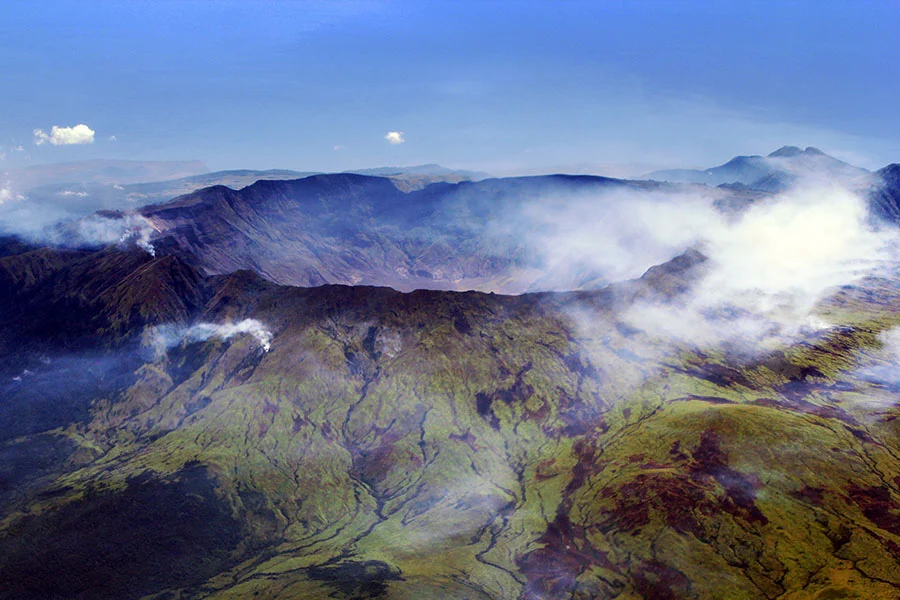The eruption occurred just before the 1815 Tambora volcanic eruption, which is famous for its overwhelming impact on climate worldwide, with 1816 given memorable names such as ’Eighteen-Hundred-and-Froze-to-Death’, the ‘Year of the Beggar’ and the ‘Year Without a Summer’ due to unseasonal frosts, crop failure and famine across Europe and North America. The extraordinary conditions are considered to have inspired literary works such Byron’s ‘Darkness’ and Mary Shelley’s ‘Frankenstein’.

However, the global deterioration of the 1810s into the coldest decade in the last 500 years began six years earlier, with another large eruption. In contrast to Tambora, this so-called ‘Unknown’ eruption apparently occurred unnoticed, with both its location and date a mystery. In fact, the ‘Unknown’ eruption was only recognized in the 1990s, from tell-tale markers in Greenland and Antarctic ice that record the rare events when volcanic aerosols are so violently erupted that they reach the Earth’s stratosphere.
Working in collaboration with colleagues from the School of Earth Sciences and PhD student Alvaro Guevara-Murua and Dr. Caroline Williams, from the department of Hispanic, Portuguese and Latin America Studies, began searching historical archives for references of the event.
Dr. Williams said: “I spent months combing through the vast Spanish colonial archive, but it was a fruitless search– clearly the volcano wasn’t in Latin America. I then turned to the writings of Colombian scientist Francisco José de Caldas, who served as Director of the Astronomical Observatory Bogotá between 1805 to 1810. Finding his precise description of the effects of an eruption was a ‘Eureka’ moment.”
In February 1809 Caldas wrote about a “mystery” that included a constant, stratospheric “transparent cloud that obstructs the sun’s brilliance” over Bogotá, beginning on the 11th December 1808 and seen across Colombia. He gave detailed observations, for example that the “natural fiery colour [of the sun] has changed to that of silver, so much so that many have mistaken it for the moon”; and that weather was unseasonably cold, the fields covered with ice and the crops damaged by frost.
Unveiling a short account written by physician José Hipólito Unanue in Lima, Peru, describing sunset after-glows (a common atmospheric effect caused by volcanic aerosols in the stratosphere) at the same time as Caldas’ “vapours above the horizon”, allowed the researchers to verify that the atmospheric effects of the eruption were seen at the same time on both sides of the equator.
These two 19th century Latin American scientists provide the first direct observations that can be linked to the ‘Unknown’ eruption. More importantly, the accounts date the eruption to within two weeks of 4th December 1808.
Dr. Erica Hendy said: “There have to be more observations hidden away, for example ship logs. Having a date for the eruption will now make it much easier to track these down, and maybe even pinpoint the volcano. Climate modeling of this fascinating decade will also now be more accurate because the season of the eruption determines how the aerosols disperse around the globe and where climatic effects are felt.”
Alvaro Guevara-Murua added: “This study has meant delving into many fields of research– obviously paleoclimatology and volcanology, but also 19th century meteorology and Spanish colonial history– and has also needed rigorous precision to correctly translate the words of two scientists writing 200 years ago. Giving them a voice in modern science has been a big responsibility.”
One last question still remains: why are there so few historical accounts of what was clearly a significant event with wide-reaching consequences? Perhaps, Dr. Williams suggests, the political environment on both sides of the Atlantic at the onset of the nineteenth century played a part.
“The eruption coincided with the Napoleonic Wars in Europe, the Peninsular War in Spain, and with political developments in Latin America that would soon lead to the independence of almost all of Spain’s American colonies. It’s possible that, in Europe and Latin America at least, the attention of individuals who might otherwise have provided us with a record of unusual meteorological or atmospheric effects simply turned to military and political matters instead,” she said.
The research is published this week in the journal, Climate of the Past.
Contributing Source: University of Bristol
Header Image Source:WikiPedia




